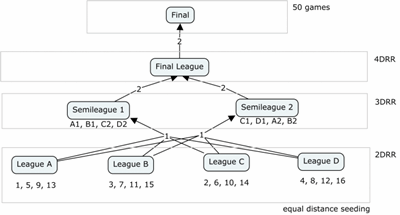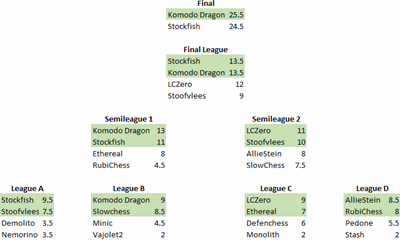FRC3 [Fischer Random Chess 3] has reached the final match, where Stockfish and KomodoDragon are tied with one win each after 29 of the 50 games have been played. The following chart from the TCEC Wiki shows the different stages of the event.
Here's the chart mentioned in the quote, taken from TCEC FRC 3 (wiki.chessdom.org):-

I ended the post on my main blog saying,
After the final match finishes, I'll have more to say about the tournament on my chess960 blog. I covered the previous edition in TCEC FRC2. In that event, Stockfish beat LCZero +8-0=42.
At the time I wrote the referenced post TCEC FRC2 (December 2020) -- which incorporated the same TCEC flow chart shown above -- the TCEC treated chess960 as a second class citizen, reported only in a section of the TCEC Wiki's home page. Since then, the main page section has been promoted to a separate page, TCEC FRC 2 (wiki.chessdom.org), which announces,
Though at the time advertised as [a] Bonus event, the TCEC Fischer Random Chess will as of now be a regular part of seasonal events.
According to the Wiki's history page, the move happened exactly a month ago:-
23:07, 27 February 2021 [...] (moved from Main page)
'Will be a regular part of [TCEC] seasonal events' -- that's one small step for TCEC, one significant step for chess960. The TCEC Wiki's 'FRC 3' page includes a chart showing the scores of the event's four stages.

A similar chart is now available on the Wiki's 'FRC 2' page. In the 'FRC 3' final, KomodoDragon beat Stockfish by a score of +2-1=47. A 94% draw rate echoes the sort of result we expect from a traditional chess match (SP518 RNBQKBNR) between engines. Will the TCEC FRC organizers be forced to dictate the chess960 opening variations, just as they do for SP518? Let's hope not.
Except for an occasional CCRL game, I can't remember ever looking at an engine vs. engine chess960 game. Is there anything to be learned from such an exercise, or is the play of the engines beyond comprehension? Watch this space; if not for FRC3, maybe for FRC4 or beyond.
[The title of my 'TCEC FRC2' post on this blog is nearly identical to the title on the TCEC Wiki, 'TCEC FRC 2'. To avoid confusion in future reports on the TCEC C960 events, I decided to change the title on this current FRC3 post.]

2 comments:
Hello Mark,
With respect to engines playing chess960, you might be interested in knowing the solution for Black in a particularly difficult SP we once discussed: http://chess960frc.blogspot.com/2014/10/another-difficult-sp-for-black.html
As a matter of fact, that SP (along with all the others) has been tested many times in computer games (http://ccrl.chessdom.com/ccrl/404FRC/). Quite a few replies have been tried for Black after 1.Ng3 by different engines but one of those deserves particular attention, as played by Houdini 5.01. Black can simply ignore White's threat:
1...c5!! (1...f6!? is also interesting but 1...Nf6? 2.Nf5 is worse as we've concluded, and my suggestion 2...g6 is a bit passive) 2.Nh5 (or 2.Nf5) 2...f6! 3.Nxg7+ Kf7 4.Nh5 Ng6.
This counter-intuitive gambit is in fact very logical upon a closer look; note that White's only piece (pawns included) that has moved so far is his h5-knight which will be forced to retreat soon. Meanwhile Black has already played ...c5 and ...Ng6, and is now intending ...d5 followed by ...Qg4! and ...Nf4!, gaining further tempi. The semi-open g-file can also be used rather by Black than by White (especially if the latter castles h-side).
One could draw certain analogies with some well-known 518 theory, e.g.: 1.e4 e5 2.Bc4 Nf6 3.Nc3?! Nxe4! 4.Bxf7+ Kxf7 5.Nxe4 d5 and Black is better despite his loss of the right to castle. Or 1.e4 e5 2.Nf3 Nc6 3.Bc4 Nf6 4.Ng5 d5! 5.exd5 Na5 6.Bb5+ c6 7.dxc6 bxc6, etc., with compensation. I'm sure one can remember dozens of similar variations. Once novel and astounding, nowadays these 518 lines do not surprise us in the slightest - but that's just because we've become too accustomed to them, as opposed to the chess960 gambits!
After 4...Ng6, a blitz game Stockfish 8 - Houdini 5.01 (CCRL 2017) continued: 5.Nf3 d5 6.b4 b6 7.bxc5 d4!? (Morphy-style! However simple 7...bxc5 was also fine for Black) 8.Qa3.
8.Bxd4? fails to 8...Rxd4! 9.Nxd4 Qxc5 and one of White's knights will be lost, while if 8.cxb6?! (ignoring development altogether) then 8...Bxf3 9.gxf3 Qh3! with a number of threats for the sacrificed material.
8...Qg4 9.Ng3 Nf4 (the roles are now reversed and it's White who has to play Rg1, because if 10.0-0? then 10...d3! 11.cxd3 Nxe2+ 12.Nxe2 Bxf3) 10.Rg1 bxc5 11.Qxc5 e5. And Black, who has a very strong initiative for two pawns, went on to win in a long and absolutely crazy fight!
Best regards,
Andrey D.
Thanks very much for pointing that out. If we could use the word 'theory' for Fischer Chess (is that still your preferred name for it?), then we would call your discovery theoretically important. I've referenced your analysis in a new post:-
17 April 2021
SP864, Reddit, Chessgames.com
https://chess960frc.blogspot.com/2021/04/sp864-reddit-chessgamescom.html
Post a Comment